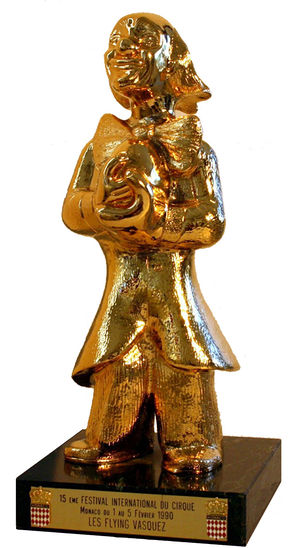Difference between revisions of "International Circus Festival of Monte-Carlo"
From Circopedia
| Line 1: | Line 1: | ||
| − | [[File:Gold_Clown.jpg|thumb|right|300px|The original version of the Gold Clown Award]]The Festival International du Cirque de Monte-Carlo (International Circus Festival de Monte-Carlo) was created in 1974 by H.S.H. the Prince Rainier III of Monaco (1923-2005) to promote circus arts—for which he had a lifelong passion. The first Festival was held from December 26 to 30, 1974 under the big top of the French circus [[The Bouglione Family|Bouglione]], installed on what was then the Esplanade de Fontvielle, a vast, rather empty landfill at the foot of the Prince's palace, which had been reclaimed from the sea. | + | [[File:Gold_Clown.jpg|thumb|right|300px|The original version of the Gold Clown Award]] |
| + | ''By Dominique Jando'' | ||
| + | |||
| + | |||
| + | The Festival International du Cirque de Monte-Carlo (International Circus Festival de Monte-Carlo) was created in 1974 by H.S.H. the Prince Rainier III of Monaco (1923-2005) to promote circus arts—for which he had a lifelong passion. The first Festival was held from December 26 to 30, 1974 under the big top of the French circus [[The Bouglione Family|Bouglione]], installed on what was then the Esplanade de Fontvielle, a vast, rather empty landfill at the foot of the Prince's palace, which had been reclaimed from the sea. | ||
In the foreword he wrote for the program, Prince Rainier said, "This International Circus Festival was created thinking of the circus community, of this family of underestimated people, so that you, attentive spectators of their efforts and of their work, could know them better, and celebrate them better." It was the first true circus festival ever presented in the Western world. | In the foreword he wrote for the program, Prince Rainier said, "This International Circus Festival was created thinking of the circus community, of this family of underestimated people, so that you, attentive spectators of their efforts and of their work, could know them better, and celebrate them better." It was the first true circus festival ever presented in the Western world. | ||
Revision as of 19:08, 17 December 2019
By Dominique Jando
The Festival International du Cirque de Monte-Carlo (International Circus Festival de Monte-Carlo) was created in 1974 by H.S.H. the Prince Rainier III of Monaco (1923-2005) to promote circus arts—for which he had a lifelong passion. The first Festival was held from December 26 to 30, 1974 under the big topThe circus tent. America: The main tent of a traveling circus, where the show is performed, as opposed to the other tops. (French, Russian: Chapiteau) of the French circus Bouglione, installed on what was then the Esplanade de Fontvielle, a vast, rather empty landfill at the foot of the Prince's palace, which had been reclaimed from the sea.
In the foreword he wrote for the program, Prince Rainier said, "This International Circus Festival was created thinking of the circus community, of this family of underestimated people, so that you, attentive spectators of their efforts and of their work, could know them better, and celebrate them better." It was the first true circus festival ever presented in the Western world.
During the Festival, a selection of some of the best circus acts in the business are presented twice to a paying audience and a Jury of circus professionals, journalists, and specialists—presided until 2005 by the late Prince Rainier III, and since 2006, by his daughter, S.A.S. Princess Stéphanie of Monaco. The Jury awards Gold and Silver Clowns, and since 2002, a Bronze Clown, in the form of statuettes originally sculpted by Paule Malé. Other prizes and trophies are awarded by the City of Monaco, and various corporations, press organizations, associations, and individuals.
The Festival presents about 25 acts each year, in two different sets of performances. The awards are presented during a closing Gala performance attended by the Prince of Monaco, and his family and guests. Traditionally, the Prince also attends every selection performance. The first Gold Clowns, which in time became the equivalent of an Oscar® to the circus world, were awarded to Alfred Court, in tribute to his exceptional career, and to Charlie Rivel. (See Gold, Silver, and Bronze Clown list.)
In 1975, the Festival was presented under the big topThe circus tent. America: The main tent of a traveling circus, where the show is performed, as opposed to the other tops. (French, Russian: Chapiteau) of the Italian circus, Nando, Liana e Rinaldo Orfei, and from 1975 to 1994, under the big topThe circus tent. America: The main tent of a traveling circus, where the show is performed, as opposed to the other tops. (French, Russian: Chapiteau) of another Italian Circus, Circo Americano-Togni. Since 1995, it has been held under a large, sedentary circus structure permanently installed on the same location, in what is now the Quartier Fontvielle, in Monaco.
In 2006, the Festival staged an extraordinary tribute to Prince Rainier III of Monaco (who had passed away the previous year), with a five-hour show that gathered the greatest assemblage of Gold and Silver Medalists ever seen (some of them performing simultaneously, like the amazing juggling duet formed by Kris Kremo and Anthony Gatto, or Oleg Izossimov sharing the ring with The Rodions and Wei Baohua & Wu Zheng). It was probably the greatest circus performance ever produced.
The International Circus Festival of Monte-Carlo is now held each year in mid-January. Presided by S.A.S. The Princess Stéphanie of Monaco, it remains today, without a doubt, the most important circus manifestation in the world, and it has become the annual rendezvous of the international circus community and of a large international audience of circus enthusiasts.
Suggested Reading
- Pierre Paret, Monte-Carlo ou la Renaissance du Cirque (Sorvilier, Editions de la Gardine, 1985) ISBN 2-88200-001-4
- Charles W. Scott, Le Cirque (Rennes, Editions Ouest-France, 1995) ISBN 2-7373-1872-6
- 40 Ans de Festival International du Cirque de Monte-Carlo (Nice, Ramel Communications, 2016) ISBN 978-2-9555379-0-9







